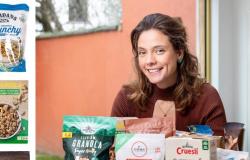
From west to east, from the marshes on the French border to Heist: you need more than a day to walk or cycle from work of art to work of art. Don’t worry, Beaufort runs until November 3. The search not only takes you to the beach, but also to all kinds of lesser-known, undiscovered places along the coast and in the hinterland.
There are 18 new works of art or art installations on display, by domestic and foreign artists. All coastal municipalities participate, except for Bredene, for financial reasons. 8 works remain permanently installed.
View here on a map where you can find the art of Beaufort:
Curator Els Wuyts Beaufort calls it “an exhibition 68 kilometers long”. For the 8th edition (‘Eight Beaufort is stormy!’) she found a common thread in “the fabric of life”, the idea of self-evident connection. “Which memories, stories, legends take place along the coast? Can we work with artists to look for places that are changing, to which they can add an extra layer with their own authentic visual language?”
Take your time to take in the entire environment
Over the past 3 years, Els Wuyts has worked intensively with artists and municipal authorities to get the right work in exactly the right place. A hidden nature reserve in Nieuwpoort or the wide beach of Zeebrugge. Figurative images or abstract installations.
Everything feels different near the sea, where your senses are stimulated. “It’s not just looking, but also smelling or touching. You take in the entire environment, together with the works of art. That’s why we ask visitors: take your time!”
View a selection of artworks from Beaufort 2024 here:
Join us: art to sit on
A first trip along the route already yields some recurring themes: you can sit on quite a few works of art and installations! In Blankenberge the French artist has Romain Weintzem three sofas placed on the pier, at the lighthouse and in a park. They have curly ornaments that are reminiscent of the Blankenberge Belle Epoque, but they are also separate seats. You sit next to your neighbor, but you look in a different direction.
‘All in time’ is the beautiful title of a work by the Taiwanese Pei-Hsuan Wang, who lives in Ghent. She has placed two oriental bronze statues next to a bench on a high dune path near the Zeepreventorium in De Haan. To gaze out to sea together.
In the beautiful Koolhofput nature reserve in Nieuwpoort you can lie down on a bronze bench, composed of the prints of the hands of hundreds of local residents. ‘At rest’ is a work by the Spanish-American Selva Aparicio.
‘Staging sea’ by Filip Vervaet, a square in full transformation in De Panne. Photo: Westtoer – Ann-Sophie Deldycke
A paved square, a fountain that follows the tides
In De Panne has Filip Vervaet an entire square was redesigned near the disused St. Peter’s Church. It will soon be transformed into a library. “Old photos show that the church was located in a dune landscape at the time. Now the square is being paved and the dune landscape is returning,” says Vervaet.
He added seven blue lanterns and a polygonal pavilion of colorful glass. You can step inside and sit on the concrete benches. In the middle a fountain sprays synchronously with the tides of the North Sea: at low tide only a few centimeters high, at high tide up to more than 4 meters high.
“The work is subject to many changes: light, reflection, sun, or as now: fog. At low tide the fountain will be a quiet place, at high tide it will be very intense.” The square is located one kilometer from the beach, but Filip Vervaet sees the work as “an announcement of the sea, so it is called ‘Staging sea’. I give a stage to the sea.”
Vervaet feels some kinship with Paul Delvaux. “His paintings take place between dream and reality. That’s how I view my work. The moment between day and night, where everything is in transformation, is a source of inspiration.”
‘Monobloc moments’ by Sara Bjarland in Wenduine. Photo: Westtoer – Ann-Sophie Deldycke
Plastic garden chairs made of bronze
And then there is the tower of garden chairs. Beaufort’s most talked about work, even before the course started. ‘Monobloc moments’ is located on a nondescript roundabout on the edge of Wenduine. Some local residents didn’t like the work either. Sara Bjarland, a Finnish artist who has lived in Amsterdam for years, explains her intention: “You see these types of garden chairs all over the world. Everyone has one. We associate them with holidays and free time, but such a plastic chair is also a symbol for the throw-away society.”
Bjarland made casts in a sustainable material: bronze. As a contrast to the perishable plastic. And she stacked 47 chairs into a chaotic tower. “As if a gust of wind had passed over it. I like to play with the idea of entropy: that everything eventually comes to a state of chaos.”
People can find it beautiful or ugly. I tried to make something that is a bit playful and poetic.
Sara Bjarland is not very concerned about the negative reactions to her first major work in public space: “I don’t think much of it and I don’t take it personally. People can find it beautiful or ugly. They have every right to that. It is often the case with art in public spaces that not everyone likes everything. I think it is important that a work of art asks questions and makes people think about society. I tried to make something that is a bit playful and poetic. And I hope some people see that too.”
‘The herring’ by Johan Creten in Oostduinkerke. Photo: VRT
Woman in and on the water
Another recurring theme in Beaufort 2024: women. A big eye-catcher is ‘The herring’ by fellow countryman Johan Creten, an enormous bronze woman with a fish in her hands. At high tide her feet are washed by the North Sea in Oostduinkerke.
Ostend also has a special woman as its guest: ‘Mother’ of the Dutch woman Femmy Otten is a white marble statue of a pregnant woman, balancing all kinds of body parts on one foot. She lies in the water at the Kursaal, not far from that other well-known statue of Ostend, ‘Fat Matille’ by George Grard.
On the monument for King Albert in Nieuwpoort there are girls playing, in iridescent green. They do a handstand or throw their arms in the air. Work by Alexandra Bircken.
View a selection of artworks from Beaufort 2024 here:
Sculpture park is growing
After eight editions, Beaufort is a permanent fixture on the Belgian coast, which attracts many tourists. It is also nice that works of art remain permanently after each Beaufort. The sculpture park has now grown to about 50 pieces. Think of Stief Desmet’s bronze wullok on the Ostend breakwater or Wim Delvoye’s “sided” excavator in Westende. And there will be 8 more after this edition.
Free payment for visitors, municipalities and provinces
The open-air exhibition is free for the public. It is the municipalities and the province of West Flanders that dig deep into Beaufort’s pockets. A city or municipality pays between 75,000 and 100,000 euros for a permanent work of art, an amount that the province doubles. Artists receive around 10,000 to 12,000 euros for a temporary loan. “A lot of money, but it’s worth it,” says curator Els Wuyts. “Sustainable materials, energy and transport are expensive, but we spend every euro cent. And I hear from the municipalities that the return is incredible.”
The return, of course, is the many tourists who go on an artistic voyage of discovery, and at the same time rent a bicycle, book a hotel, or go out for dinner. But Beaufort is so much more. Els Wuyts: “I believe in the power of art, which can make a difference and change people’s lives.”
Beaufort is a way to experience and feel art up close
“The DNA of Beaufort is so nice because it is accessible here and now. If someone suddenly needs time at sunset to look for another imagination, then that is possible. There are no opening hours, no queues. It is a way to to be able to experience and feel things up close. And who knows, it may be an incentive for people to visit other art projects. Anyone who comes here to taste them can get a taste for it.”
Beaufort. Triennial by the Sea runs from March 27 to November 3, 2024. Free admission everywhere; a handy guide with maps and explanations costs 2 euros and can be found in the tourism offices.
Tags: Tower garden chairs bronze woman herring sea tidal fountain #8th edition Beaufort brings
-




